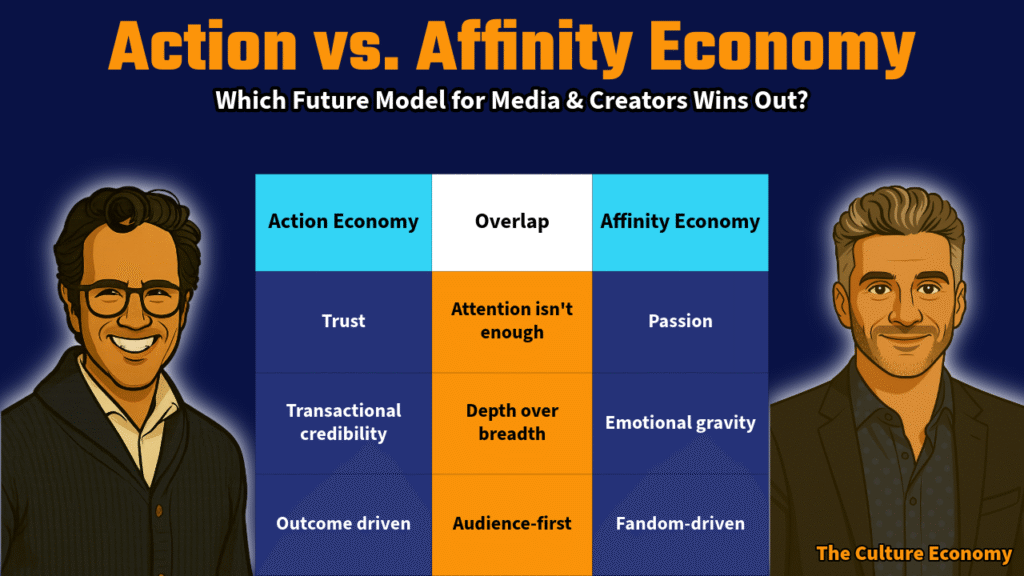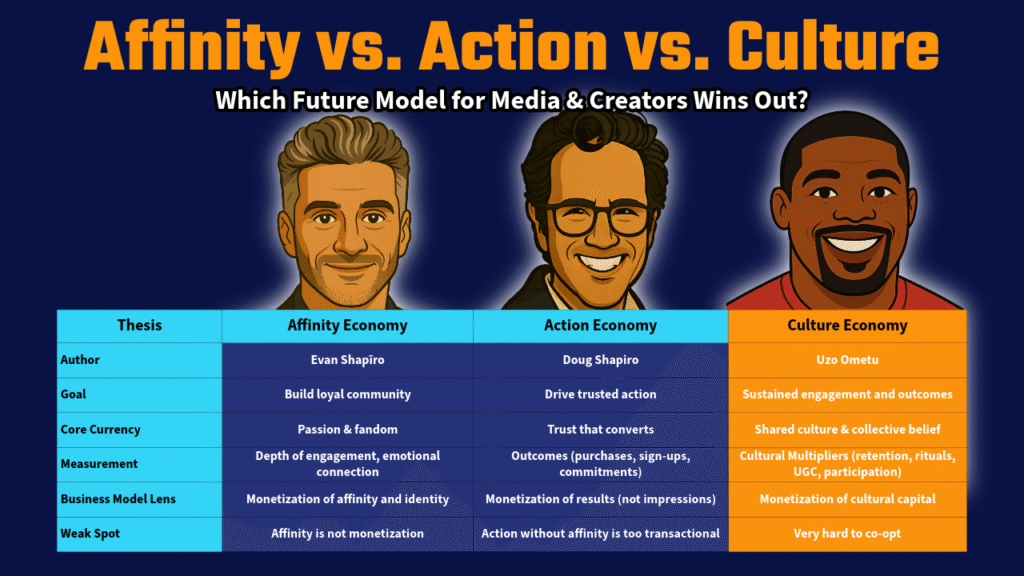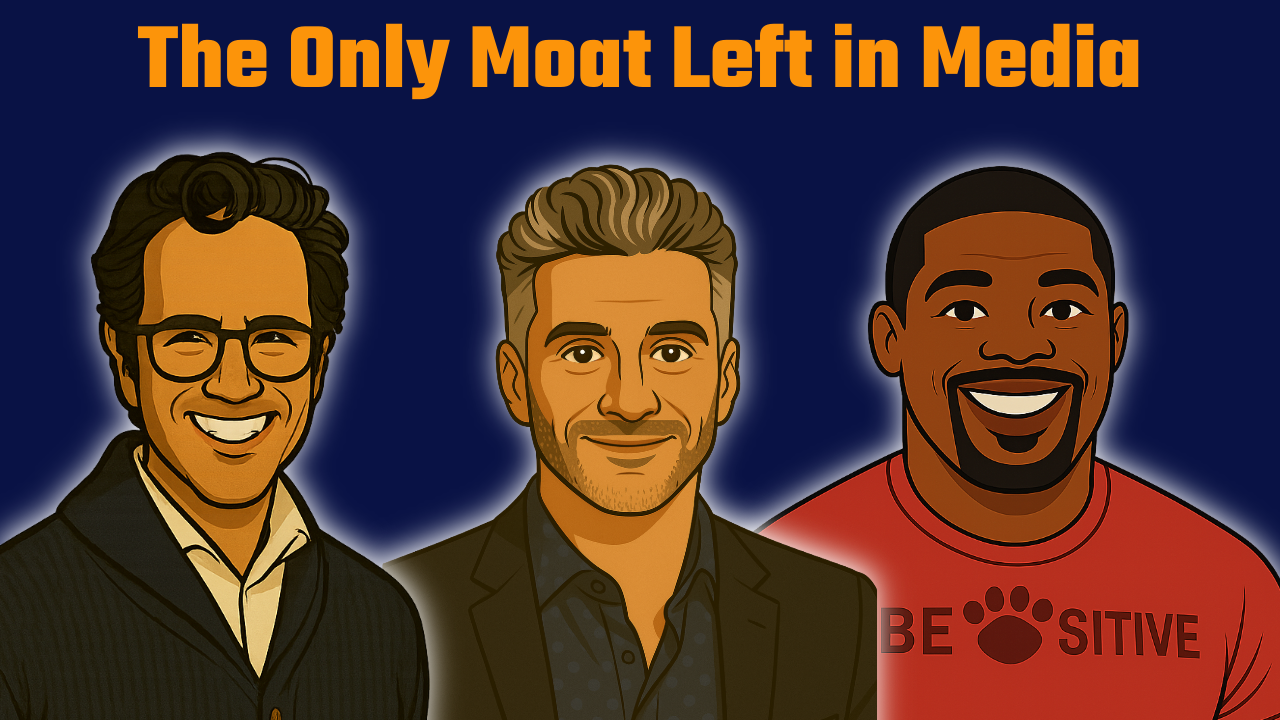If I weren’t an avid user of LinkedIn, I might not know the work of Evan Shapīro and Doug Shapiro. Both are doing what I’ve always dreamed of—writing sharp, consistent analysis about the future of media. Evan with his brash, fact-based illustrations of the media universe. Doug with his measured, framework-driven analysis of technology and strategy.
I love their posts on LinkedIn. But I rarely comment when I agree—what’s left to add? So when I do comment, it’s when I see a gap.
Today, that gap feels big enough to write a whole newsletter about it.
The Affinity Economy
Every year, Evan Shapīro drops a new framework for how media really works, and his recent post on the Affinity Economy is no different.
His core claim: “The economics of community and finances of fandom now define the media ecosystem.” In other words, we’re no longer in the Attention Economy. The new currency is affinity itself.
He’s formalized this in what he calls the Key Passion Index: a KPI that measures depth of engagement over reach. It’s a KPI stressing that the value of a media brand or creator isn’t how many people they reach, but how many people care deeply, consistently, and demonstrably.
Evan points to Taylor Swift as Exhibit A: despite having fewer Instagram followers than Ariana Grande, Lionel Messi, or Kim Kardashian, Swift commands 3x, 4x, and even 8x higher engagement rates. That differential isn’t just nice-to-have, it’s a strategic moat.
Evan’s thesis is a wake-up call: money will flow to the deepest emotional connections. Fandom is no longer a byproduct of the business. It is the business.
The Action Economy
Doug Shapiro’s Action Economy picks up where attention leaves off. In his essay Trust is the New Oil, he writes that we’re shifting from the Attention Economy—where impressions and clicks were monetized—to an era where the scarce, valuable resource is trust that drives action.
His argument is blunt: in an AI-saturated world, attention is cheap. Content abundance devalues novelty. Algorithms will be gamed for reach. But none of that will consistently inspire a person to act; i.e., subscribe, purchase, commit. Only trust can.
Doug distinguishes between two kinds of trust:
- Signal-based trust: The kind you can borrow from associations or influencers, but which is shallow and easy to manipulate.
- Earned trust: Built over time through credibility and consistency, harder to fake, slower to accrue, but far more durable.
Doug’s implication here is crucial: if attention was the oil of the last era, trust is the oil of the next. Ratings, impressions, GRPs, even follower counts, all lose value in a noisy world. In the Action Economy, the relationship between content and consumer must be built on a trust that can inspire real action; otherwise, it ceases to matter.
The Overlap
Taken together, their two views share a good amount of common ground:
1. Attention is dead as currency.
Evan rejects “reach & frequency” in favor of his Key Passion Index.
Doug declares that in a world of AI-driven noise, impressions lose value entirely.
2. Depth of connection is the future.
Evan says fandom and engagement are the “finances of the media ecosystem.”
Doug says only trusted relationships can drive meaningful actions.
3. Audience-first beats platform-first.
Both argue that winners in media design for the end user, not for legacy distribution metrics.
The Divergence
Where they diverge is in what they elevate as the ultimate currency:
Evan: Passion-as-capital.
In the Affinity Economy, emotional gravity drives belonging, community, and revenue. His KPI is depth of engagement. Fandom isn’t a byproduct — it’s the business.
Doug: Trust-as-capital.
In the Action Economy, credibility that inspires action is the scarce resource. The metric isn’t engagement but outcomes: sign-ups, purchases, real-world actions that only trust can unlock.
Each would likely critique the other:
- Evan might say Doug’s Action Economy is too transactional: trust without passion risks becoming hollow and short-lived.
- Doug might say Evan’s Affinity Economy is too emotional: passion without monetization can be commercially unsustainable.
And here’s the problem: they’re both right.
Which leads to the bigger gap: if passion alone risks fizzling, and trust alone risks commoditization, what actually sustains both over time?

What They Both Miss
Both of their worldviews make sense.
Passion is increasingly important. As I outlined in Joe Budden’s $20M playbook, people engage with him again and again because they’re passionate about the subjects he covers.
And outcomes are undeniably becoming central to media. The rise of retail media and the fact that so many of us are now using ChatGPT over Google prove that trusted actions are increasingly the goal.
But as thoughtful and expansive as Evan and Doug’s frameworks are, I find them incomplete.
In the Affinity Economy, creators focus on making people care—but not on reliably turning that care into durable revenue. Joe Budden converts nearly 5% of his YouTube following into paid subscribers. By comparison, most creators with high engagement struggle to convert even 1%. Passion alone doesn’t guarantee sustainability.
In the Action Economy, trust drives a viewer to act—but what ensures they act again? Trust may unlock one purchase, but if it erodes for one creator and rises for another, audiences will simply shift their loyalty. Transactions without deeper roots are fragile.
And neither view fully addresses what happens in a cluttered, AI-accelerated media world. Fandom risks becoming more fleeting when bigger, newer, “better” content appears every hour. And can any third-party media company truly build enduring trust when AI feeds consumers personalized streams of information tailored to confirm their own worldview? I don’t think so.
Here’s where I land:
- Passion fades without trust.
- Trust fades without passion.
- And even together, they can’t sustain themselves in the age of AI.
Both models miss one essential piece: a mechanism that continuously reinforces both affinity and action. The unanswered question is simple: why will people keep caring—and keep acting—over time?
Filling the Gap
Clearly, these 2 world views are missing something that sustains the very values they elevate.
Take “affinity”. Why do people keep showing up for Taylor Swift—not just listening to her music, but buying merch, booking flights, and dragging friends and parents to three-hour shows? Passion alone doesn’t sell out 60 stadiums. Indie bands have superfans, too—but they’re not selling out stadiums. The difference is that Swifties don’t just love Taylor, they see themselves inside a larger story. Being a fan means joining a tribe, signaling an identity, and participating in rituals that extend beyond the music. Even casuals and “plus-ones” buy in, because they’re not just attending a concert, they’re stepping into a cultural moment—even if only for a moment.
Now take “action”. People make purchases all the time. But what separates a fleeting trial from a lasting subscription? A LinkedIn post I agree with might inspire me to pay for a Substack for a month. But one off-note essay, and I’m gone. Compare that to The New York Times, or even newer players like Axios or Stratechery. Their retention isn’t built on a single great article. It’s built on a collective sense of what they stand for. Readers believe they’re joining a worldview, a community of people who see the world through the same lens. That’s why they stay, even when they disagree with an individual take.
So what’s missing? What is it that Swifties have beyond a passion for Taylor? How does The New York Times grow while so many other publications fade?
The answer is written at the top of this page. The missing ingredient in both the Affinity Economy and the Action Economy is the connective tissue that turns fandom into shared meaning and transactions into shared belief.
Shared culture.
Introducing: The Culture Economy
Affinity explains why people care. Action explains why they convert. But neither explains why they return—again and again.
The Culture Economy does.
The Culture Economy is the system where shared culture and meaning become capital; turning passion into trust, trust into action, and action into recurring, lasting markets.
And the emphasis on “shared” matters. Culture isn’t invented out of thin air. No creator can manifest a universe and expect people to care. To have cultural currency is to tap into something bigger than yourself.
Look at our ongoing case study: Taylor Swift. She could have the same talent, charisma, and work ethic, but if her instrument were the banjo instead of pop anthems, she wouldn’t be selling out stadiums. Why? Because she wouldn’t be plugged into the larger cultural current of global pop music: a web of rituals, language, and identity billions already share. She didn’t create that current. She built on it, expanded it, and in turn, became one of its defining figures.
The same is true of Beyoncé, who didn’t invent R&B but deepened and globalized it. Or Star Wars, which built on pulp sci-fi and Cold War myths. Or ESPN, which scaled what had long existed in local sports talk culture. Nearly everything that “takes over” culture does so by riding—and then reshaping—a preexisting current.
In the worldview of The Culture Economy, fandom becomes durable when culture multiplies one person’s passion into shared meaning with others. Actions become repeatable when culture multiplies individual trust into shared belief across a community.
So if the Affinity Economy is where passion creates value, and the Action Economy is where trust becomes currency, then the Culture Economy is the force multiplier: compounding both by tying them to broader social meaning.
Which is why, if you’re building a media company, a creator business, or a digital brand of any sort, culture isn’t optional. It’s the foundation for scale, sustainability, and global reach.

Why Culture?
It’s no coincidence I named this worldview after this newsletter. Looking back at my career—from throwing parties after college, to launching a sports blog, to chasing a job at YouTube, to building a streaming startup for Black creators—the common thread was always culture. Not just media, not just creators, but the ways people gather, share, and express identity together.
And yes, when I say “culture,” I mean Black culture first. It’s the lens I see the world through, and I believe it’s the engine driving much of what becomes mainstream in music, fashion, film, and digital platforms. That’s why so many of the case studies here focus on Black creators and Black audiences: they sit at the center of cultural production.
But culture is also universal. It’s in the songs you replay, the memes you reshare, the foods you crave, the neighborhoods you call home. Culture is the backbone of society. So if you want to capture attention or drive action, you have to tap into a culture people already inhabit.
That’s why I frame my work around culture. Affinity and action describe pieces of the puzzle: passion, trust, transactions. But culture is the one thing everyone participates in. It’s the connective tissue that endures when attention fades, when passion cools, and even when trust wavers.
Root your work in culture, and you’re not chasing trends. You’re building on the strongest foundation there is. That’s the work I’m committed to with this newsletter.
The Future of Media
Rightly or wrongly, the biggest question about the future of media is the impact of artificial intelligence.
In an AI-saturated world, affinity will be harder to hold. Content abundance devalues novelty. When anyone can make “good enough” content, what makes you come back to a particular creator? Their style, their ideas, their voice? All of it can be mimicked by AI—over and over. And if you can’t be unique, how do you inspire real passion?
Trust will also be harder to earn. Every creator’s output will be compared against an endless stream of AI-generated articles, videos, and takes—some echoing you, others contradicting you. Worse, algorithms will flood people with the information (or misinformation) they already want to hear. If your work doesn’t align, it may never break through the confirmation bias.
And yes, AI will even mimic culture. We’ll see AI-driven YouTube channels, meme accounts, and digital personas that feel rooted in cultural touchpoints. But here’s the limit: AI can remix culture, but it can’t expand it. It can’t invent new rituals, spark new beliefs, or replicate lived cultural experience.
AI “fanfiction” will flood the web, as anyone can spin up alternate Harry Potter universes with the right prompts. But AI can’t replace the ritual of reading Harry Potter at midnight in bed, or the experience of visiting the theme park in a robe. Only humans can deliver those authentic, lived cultural moments.
The same goes for expertise. AI will churn out thousands of posts about tech, Big Tech 10Ks, and the future of AI itself. But can it replace the trust Ben Thompson has built over a decade at Stratechery? A trust that is amplified and scaled by following the trends, players, and sentiments rooted in tech culture—one that his readers feel they are actively a part of? It’s unlikely.
So as AI-generated creators fight to make you love their content, and as they try to build fragile strands of trust with their audiences…
In this age of noise, the only true moat will be culture.
It’s What Makes You Stay
Shout out to Evan Shapīro for showing why media must be built on what audiences love. And thanks to Doug Shapiro for reminding us that creators need a strategy for what audiences do.
My thesis builds on theirs: content rooted in culture is what keeps audiences coming back.
If there’s one thing my career has taught me—from running a sports blog, to working at YouTube, to launching a startup with Black creators—it’s that shared culture is the bridge between affinity and action.
- My blog took off when I tapped into the culture of fantasy sports.
- At YouTube, a culture war between legacy & niche media redefined trust.
- At BlackOakTV, I saw cultural identity turn casual viewers into loyal fans.
That work. Those creators. These audiences. They are why I believe the future of media belongs to The Culture Economy.
Because in the end: affinity makes you care, action makes you act, but culture makes you stay.
